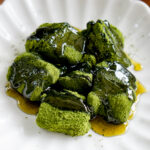Matcha Warabimochi Recipe
Make matcha warabimochi with matcha powder and matcha syrup. Read the recipe notes for common flour substitutions for warabimochiko.
Servings: 4 people
Ingredients
- 100 g warabimochiko See notes for substitutions
- 100 g granulated sugar
- 600 mL water See notes
- 24 g matcha for dusting about 1/4 cup
- 1 tbsp matchamitsu (matcha syrup)
Instructions
- In a small pot, mix warabimochiko, sugar, and water.
- Place pot over medium-high heat and cook, stirring until the mixture starts to thicken.
- Reduce to medium-low heat and continue stirring. The liquid should begin to clump up and form glue-like lumps. Stir vigorously to evenly cook the jelly.
- When all the liquid has become jelly-like, turn off the heat and continue stirring as the residual heat finishes cooking the remaining liquid and the globs of jelly look uniform in color. It should be much less opaque than in liquid form, but it will not turn 100% translucent.
- Transfer to a small, rectangular container (warabimochi should be about 3/4 inch thick) lined with plastic wrap and lightly sprayed with water. Cover and chill for 15-20 minutes or until the warabimochi is no longer hot to touch. Do not leave warabimochi in the fridge too long, or it will harden and dry out.
- Sift a couple teaspoons of matcha on a clean surface and transfer cooled warabimochi on top. Roughly cut warabimochi into 3/4 inch squares and toss in the remaining matcha to cover all sides.
- You can continue to chill warabimochi for up to another hour to let it completely cool before serving with matchamitsu. Warabimochi should be eaten the day it is made, but leftovers can be kept in an airtight container at room temperature as long as they haven't been covered yet in syrup.
Notes
- Warabimochi is made from honwarabiko, which is expensive and very hard to find, or warabimochiko, which is made from a substitute starch. Common substitute starches are made from sweet potato, tapioca, or Japanese arrowroot. Tapioca starch is fairly easy to find in American grocery stores, so you can use that as a substitute even if you can't find a pack of warabimochiko. Arrowroot starch is also fairly common but may have some slight differences in texture compared to Japanese arrowroot. Use at your own discretion.
- I've seen different directions for how to cook warabimochi on stovetop. My specific bag of warabimochiko instructed to boil the liquid and then turn down the heat and that the finished product would be not be completely translucent. I've seen other instructions that say NOT to let the mixture boil and that you should cook until perfectly translucent. I assume the differences may depend on the type of starch used. For me, I did not have to wait until the mixture boiled to see the liquid starting to clump up into a jelly, so I turned the heat down at that point and continued cooking until almost all the liquid was gone and the resulting product was fairly translucent and evenly colored.
- You can add more water if you like a softer texture, but the end result will be more blobby and not quite nicely cut into rectangles. I frequently like to use around 600mL water when I want something super soft and stretchy.
- You can buy matchamitsu at Japanese markets, but if you can't find it, you can also mix a substitute at home. Mix 1/2 tsp matcha with 1 tsp water to form a paste. Then mix the matcha paste with 1 tbsp maple syrup or corn syrup.
- I highly recommend using a light blend of matcha, like Ippodo Tea Wakaki blend, otherwise your warabimochi will taste very bitter.
